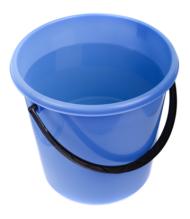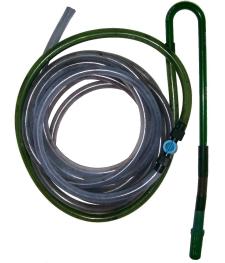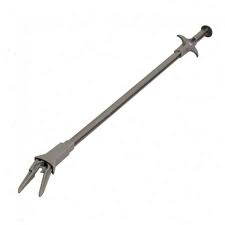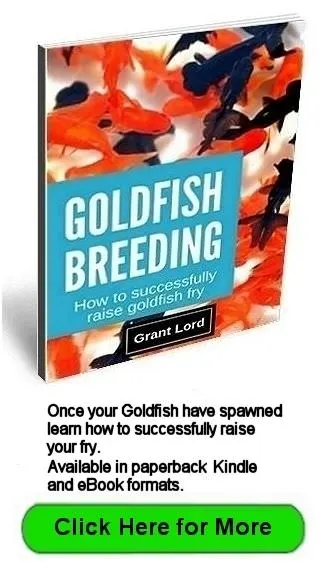Goldfish Aquarium Cleaning
Regular maintenance is the key to avoiding problems with your aquarium.
Aquarium cleaning isn’t everyone’s favorite job, but regular maintenance avoids having to strip down the aquarium completely. This should only have to be done rarely if disease or some other disaster has occurred.
Regularly having to strip down a large aquarium in the living room is why many enthusiasts give up fish keeping. Cleaning should only take 30 minutes every two weeks if you are doing it correctly.
Cleaning is separate from water changes which may have to be done more frequently depending on fish numbers and other factors.
Tools and Equipment Needed For Aquarium Cleaning
None of the basic equipment required is expensive or complicated to use. The list is as follows:
Algae Scraper
All aquariums get some algae growth on their sides over time. It is a sign of a healthy aquarium, but it does spoil the look of the aquarium.
Warning! If you have purchased an acrylic aquarium, make sure you have the correct algae scraper. The packaging should say it is specifically for cleaning acrylic aquariums. If it doesn't it will scratch the soft acrylic.
I'm also not a fan of the magnetic cleaners for acrylic aquariums. No matter how careful you are, gravel or some other hard material gets trapped between the acrylic and the pad and before you realize it, you have scratched the aquarium.
2 gallon plastic bucket

The bucket is used to hold any items removed from the aquarium such as trimmed or dead plant material.
It should only be used for aquarium maintenance as fish are very sensitive to household cleaners.
Siphon hose
This is one of the handiest pieces of equipment you will own. The siphon hose is made up from a length of 5/8” (15mm) ID clear flexible PVC hose that is long enough to reach outside the house.
It has a filter inlet tube attached to one end that is cut to suit the depth of the aquarium and the amount of water you want to drain. This allows you to start the siphon and get on with other tasks without having to worry about the water level or fish getting sucked up.
Gravel cleaner
You can attach the gravel cleaner to the end of the siphon hose and clean the gravel as the water is siphoned out.
Planting tongs
These are useful for deeper aquariums. They are handy for removing dead fish and other objects from the bottom without getting your hands wet.
Some multi-function tongs have changeable heads that can be swapped from grasping tongs to plant trimmers.
Aquarium Cleaning In 18 Steps
Having run an aquarium hire business for many years, I created an 18 step process for maintaining the aquariums.
I am assuming that you have an aquarium filter installed.
1. Observe the fish for a few moments to check for disease.
2. Check the plants are algae free and there is evidence of new growth.
3. Check the filter flows and aerator output (if installed).
4. TURN OFF THE POWER.
5. Remove the aquarium cover.
6. Check water temperature.
7. Test water pH.
8. Test water nutrient levels (nitrates).
9. Clean the sides of algae.
10. Trim the plants or replace.
11. Clean the filter (if scheduled or necessary).
A filter shouldn’t need cleaning more than a few times a year. If it is clogging regularly, it will be caused by too much plant debris, food or fish waste entering the aquarium…or the filter is too small.
12. Hang the siphon hose in the aquarium and start the siphon. Clean the gravel if it appears clogged with dirt.
If the siphon hose purchased is long enough, it can be draped along the floor, and passed outside through a door or window. This saves carrying buckets of water through the house.
13. Replace the water (add water conditioner, check the filter is primed).
To fill the aquarium, attach a garden hose to the end of the siphon hose and reverse the flow back into the aquarium. Before attaching the garden hose, flush it to get rid of stale water.
If no more than half the water is being replaced, water straight from the tap shouldn't cause distress to the fish, even during winter. In areas with extreme winter temperatures, check that the water from the tap is no more than 20 degrees Fahrenheit (7oC) lower than the aquarium water.
The temperature change doesn’t seem to worry the fish because it is made gradually.
14. TURN ON THE POWER.
15. Add supplementary food (live food, treats).
16. Replace the aquarium cover.
17. Clean the outside glass of the aquarium with glass cleaner.
18. Record changes/problems in the maintenance record book.
If you are well organized, a 100-200 liter (25-50 gallon) aquarium should take no more than 30 minutes to clean.
The amount of cleaning required can increase significantly if you place your aquarium where it gets too much natural light, causing algae to take over the aquarium and kill the plants.
Find out the best place to set up your aquarium to minimize aquarium cleaning here.
A high quality filter that matches your aquarium filtering needs really is your best friend. It will cut down the amount of maintenance you will need to do, and gives you a much greater safety margin if conditions change in your aquarium.
Top of Goldfish Aquarium Cleaning page








